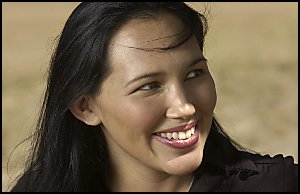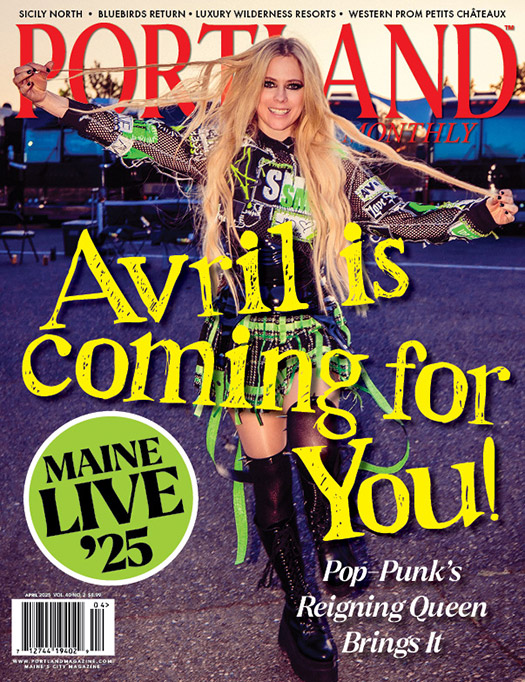Chasing Molly
The actress who voiced Pocahontas is out to rescue Native Americana from Hollywood’s cliches by putting the story of Maine’s iconic, silent-film star–who danced for royalty and took Paris by fire–up on the silver screen.
By Colin W. Sargent
 The voice of Disney’s Pocahontas is seductive and smooth as she speaks on the telephone–exactly the impression actress Irene Bedard doesn’t want to convey, because even our politically-correct-obsessed 21st century dismisses Native Americans by over-romanticizing them.
The voice of Disney’s Pocahontas is seductive and smooth as she speaks on the telephone–exactly the impression actress Irene Bedard doesn’t want to convey, because even our politically-correct-obsessed 21st century dismisses Native Americans by over-romanticizing them.
Bedard, who bears an uncanny resemblance to Indian Island’s princess Molly Spotted Elk (born Mary Alice Nelson), dreams of producing a movie about the raven-haired beauty.
The 1920s Penobscot actress, dancer, musician, poet, and nightclub siren performed in Broadway venues, danced for European royalty, and lived the life of a glamorous ex-pat in Paris until forced to flee during World War II. It’s a story full of irony and wistfulness that Bedard first became aware of over a decade ago when she read the actress’s biography, Molly Spotted Elk: A Penobscot in Paris, by Bunny McBride, a Pulitzer Prize-nominated writer who spends summers in Bar Harbor researching and working with the Abbe Museum. The book vividly recounts the story of Maine’s Penobscot Nation and its famous daughter.
But can a film project about a gorgeous Native American starlet–”the first,” Bedard points out, who unabashedly shimmered on screen–avoid stereotypes?
Bedard knows about these dangers too well. She’s got Maine roots (her mother was an Inupiat Eskimo and her father a French Canadian/Cree from Skowhegan), and she, too, has struggled as an actress to find the courage to rise above exploitation, even from well-meaning production companies.
“It’s so funny,” says Bedard, 43, of the Disney role that made her a household voice to little girls across the globe. “Pocahontas was only eleven and a half when she met John Smith, and twelve when she threw herself over him to save him.”
So why did a politically aware woman of twenty-seven agree to play the part?
“Growing up, I loved Disney on Sunday nights. You’d see the castle and Tinkerbell going across the screen. I knew being part of something like that could be something your grandchildren will see.”
Disney or not, it was still an emotional decision. She grew up hearing the word “Pocahontas” used pejoratively. “To me, the one thing that stuck in my mind was having been called ‘Pocahontas’ in a derogatory way.” (As in, ‘Nice parallel parking, Pocahontas.’)
Besides, this serious actress had already experienced the indignation of having her character role neatly wrapped in a pretty little package in the Disney live-action film Squanto: A Warrior’s Tale.
“My first line in the movie is, ‘Was there good hunting, Squanto?’ A stereotypical line. He’d just come back from the ocean and had been gone for weeks on a hunt. Men don’t survive from this! There was this huge relief and celebration, and the very first thing she says is, ‘Squanto, was there good hunting?’ I fought the battle, and I lost the battle to a certain point. What I did was, knowing it was a Disney movie, I ran up to him and said the same words in a different way.”
Bedard’s intentional change of tone–from innocent and earnest to suggestive and coquettish–made her point, and then it went straight to the cutting-room floor. Her dialogue was edited to a single word: “Squanto!”
“But I accomplished my goal in sort of a sideways way. I learned I not only had to stand up for the personal directives of my character but also the cultural perspectives of my character. The best way was not to say, ‘No, this doesn’t work.’ It was, ‘Let me show you, let me teach you, here’s an alternative.’”
On the set of Lakota Woman, knowing Bedard was wrestling with the guilt and wonder of taking on the Pocahontas gig,“the famous Native American actress Tantoo Cardinal saw me thinking about it and said, ‘Irene, I know you. You’re strong and a native woman. I know you will fight every battle that needs to be fought. You are the right person for this job. Take it.’
“It was another ‘manifest destiny’ part. I’d just done Squanto, one of the manifest destiny characters, and now it’s Pocahontas–a manifest destiny character written into a history by the victors…[portraying Indians as those] who helped and pushed along the prevailing society. I went down and met with [Disney].”
Which brings us, after many ambitious roles and hunts for edgy, modern parts for Native American actresses, to Bedard’s dream of chasing Molly Spotted Elk and her legend to make a movie that will make a difference, that will not require “compromised truth.”
“I have started Bundle of Arrows production company. Our first projects are a couple of contemporary projects with full native cast and crew, but Molly Spotted Elk is something I’ve had in mind for so long. I’d like to work with a French production entity or director so we can shoot in Paris. Her story is epic in scale, so I need a director who can do it.”
Because Molly Spotted Elk was a gifted poet and what the Penobscots call “one of the hard ones” (that is, endowed with spiritual powers), Bedard envisions mystical interior monologue to accompany Molly’s deep story arc.
“She’s coming from this small place and going to New York City and trying to fit into the prevalent society and realizing she’s not going to be able to take what’s truly at her heart–her cultural beauty–with her, because there was no place for it to shine.”
Molly’s search for cultural acceptance eventually draws her to Paris, where–like Josephine Baker–she found appreciation for her caramel skin and unusual cultural heritage. “[It was] go to Paris, go to what’s close to your heart, you know, make this trek across the ocean to be this really exotic human being who doesn’t speak their language, yet [in daring to do this] she finds a way to become herself with her particular artistic beauty and really grow and become a beautiful, shining thing.”
Molly was happy in France, where she met and eventually married French political journalist Jean Archambaud. They had a daughter, Jean. When World War II hit France, Molly and her daughter had to flee across the Pyrenees without her husband (a known anti-Nazi activist), who was directing the Red Cross Relief efforts near Bordeaux. Molly never saw or heard from him again.
It was a turning point in Molly’s life. “She went through a real dark period and was institutionalized for a time. Then she went to New York, but her soul was damaged…I think going back to Indian Island in Maine and discovering her poetry and dance and basket weaving and the creativity–I think that idea, of walking in beauty, was her triumph in life. She learned how to find beauty on her own terms.”
Asked which scenes she’s itching to shoot first, Bedard says immediately, “I think of her being in the chorus line in vaudeville, where there’s this line of women and they move at the same time, wear the same clothes, and yet there’s something so different, so out-of-this-world, about her.
“When she fought to say, ‘Hey, I want to perform traditional dances,’ they put her in a short outfit with a feather on her head. It was such a stereotype in the shape of sexual dismissal and spiritually where she wasn’t coming from.”
As for how Bedard will avoid caricature within the Molly project, she’s going to visit Maine extensively to better understand Molly’s haunts here.
“Oh, yes. Definitely. My father actually was from Skowhegan, so I have family in Maine that I visit; in fact, I’ll be there this summer.”
Because she understands the importance of getting things right, Bedard is willing to take her time with this project.
“I’m just one woman, doing the work I can do. I don’t speak for all Native Americans because no one can. I try my best to be honest and truthful…My whole concept is to bring us into contemporary society. We’ve done the historical stories; now it’s time to be romantic, comedic, and contemporary, and a lot of Molly’s life [resonates with this].”
What might Molly tell Bedard, her fellow actor, from across the years once filming begins? “She’d tell me that loving her daughter, and the love she had for her husband, was the most important work of her life. The love of her people. For her, it’s all about finding your true heart through love and beauty.”





0 Comments